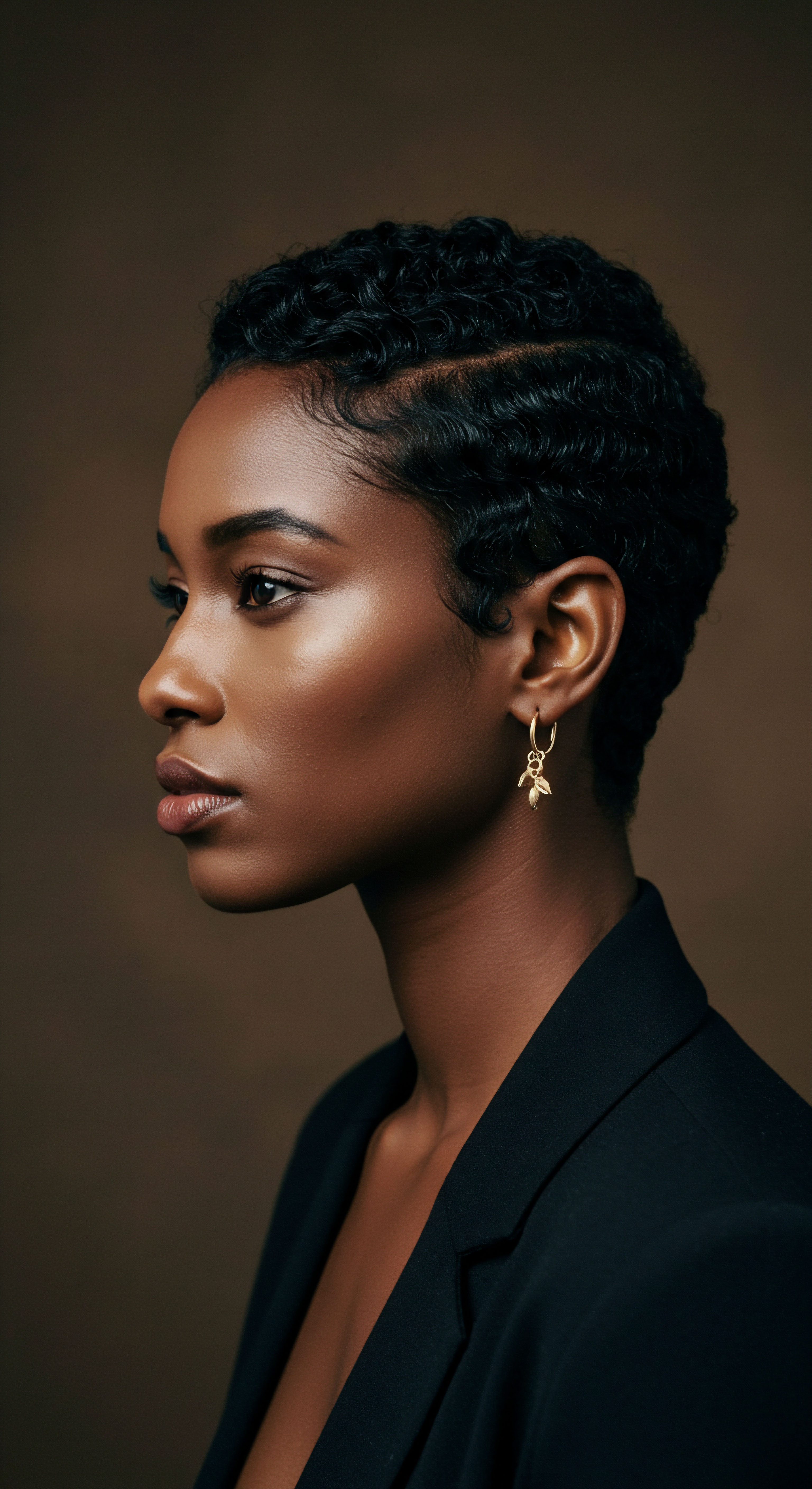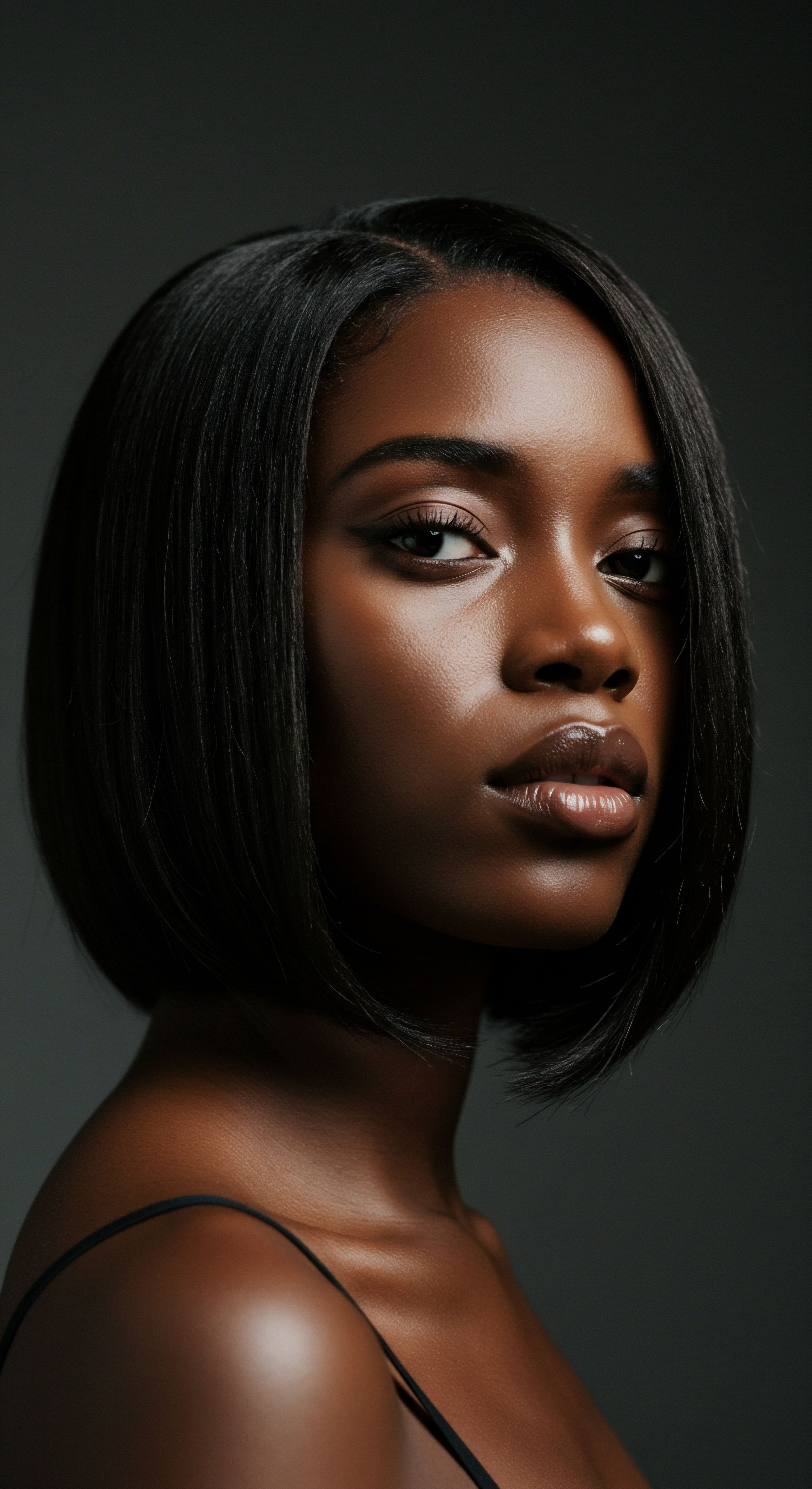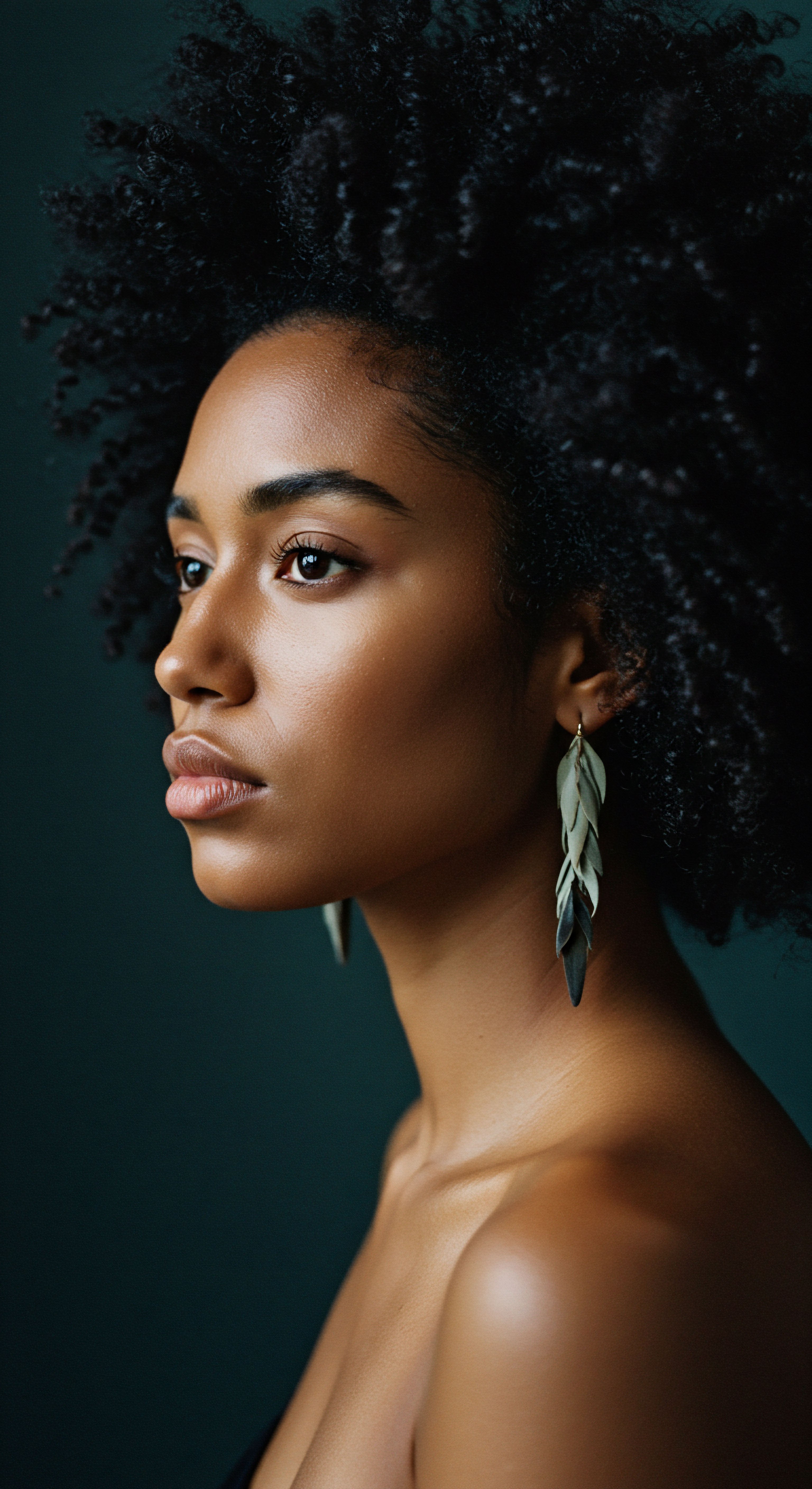
Roots
The very essence of our hair’s unique character begins not at its visible length, but within the hidden architecture beneath the scalp. It is here, nestled in the dermis, that the hair follicle, a tiny yet profoundly influential organ, orchestrates the symphony of texture that distinguishes each strand. To truly appreciate the diverse expressions of hair across individuals and cultures, one must first journey into this microscopic realm, understanding how the subtle contours of a follicle sculpt the very form our hair takes as it emerges into the world. This elemental understanding is the grounding presence Roothea seeks to offer, a gentle invitation to perceive hair not merely as a cosmetic adornment, but as a living testament to biological artistry and ancestral whispers.

The Follicle Anatomy Unveiled
The hair follicle is a complex, miniature ecosystem, far more than a simple tube from which hair grows. Its structure, particularly its shape and the angle at which it exits the scalp, holds the fundamental key to the hair’s eventual curl pattern. A Straight Hair Follicle typically possesses a round cross-section, allowing the hair shaft to grow straight up and out.
Conversely, the more pronounced the curl, the more flattened or elliptical the follicle’s cross-section tends to be. This flattened shape forces the keratinocytes—the cells that make up the hair shaft—to arrange themselves unevenly as they mature and harden, causing the hair to bend and twist upon itself.
Consider the intricate cellular choreography within the follicle. The dermal papilla, a small, cone-shaped structure at the base, feeds the hair matrix cells, which rapidly divide and differentiate to form the hair shaft. As these cells move upwards through the follicle, they undergo keratinization, a process where they fill with fibrous proteins called keratin and die, forming the hardened hair shaft. The shape of the follicle lumen, the internal space through which the hair grows, acts as a mold.
If this mold is perfectly circular, the keratinizing cells arrange symmetrically, resulting in a cylindrical hair shaft. If the mold is oval or ribbon-like, the cells are compressed unevenly, leading to an elliptical or flat shaft that curls as it lengthens.
The hair follicle, a hidden architect beneath the scalp, dictates the unique curl pattern and texture of each strand.

The Geometry of Curl
The degree of follicle ellipticity directly correlates with the tightness of the curl. A slightly oval follicle might produce a wavy strand, while a highly flattened, kidney-bean-shaped follicle will yield tightly coiled or Z-patterned hair. This geometric relationship is not merely theoretical; it is a visible phenomenon observed under microscopy, revealing the precise biological blueprint that determines our hair’s inherent texture.
Beyond the cross-sectional shape, the angle of the follicle’s insertion into the scalp also plays a part. Follicles that grow perpendicular to the scalp tend to produce straight hair, while those that grow at a more acute angle, often curving beneath the skin before emerging, are more likely to produce wavy or curly textures. This angle influences the direction of growth and can contribute to the overall movement and body of the hair.
Moreover, the distribution of disulfide bonds within the hair shaft, which are crucial for maintaining hair’s structural integrity and shape, is also influenced by the follicle’s geometry. In straight hair, these bonds are evenly distributed. In curly hair, they are often unevenly distributed along the length of the strand, contributing to the hair’s tendency to coil and hold its curled shape. This unevenness is a direct consequence of the asymmetrical keratinization process dictated by the flattened follicle.
| Follicle Cross-Section Round |
| Hair Texture Straight |
| Hair Shape Cylindrical |
| Follicle Cross-Section Slightly Oval |
| Hair Texture Wavy |
| Hair Shape Slightly Elliptical |
| Follicle Cross-Section Oval to Flat |
| Hair Texture Curly |
| Hair Shape Elliptical |
| Follicle Cross-Section Highly Flattened/Kidney-Bean |
| Hair Texture Coily/Kinky |
| Hair Shape Ribbon-like/Highly Flattened |
| Follicle Cross-Section The internal architecture of the follicle directly shapes the emerging hair strand. |

Cellular Architects of Texture
The very cells that build the hair shaft, the keratinocytes, behave differently depending on the follicle’s shape. In a round follicle, these cells are arranged symmetrically, leading to an even distribution of keratin. However, in an elliptical follicle, the cells on the inner curve of the follicle are compressed differently than those on the outer curve.
This differential growth and compression result in an uneven build-up of keratin, particularly the types of keratin and their associated proteins, along the hair shaft. This inherent asymmetry is what causes the hair to curl.
Recent research suggests that specific proteins, such as trichohyalin and keratin-associated proteins (KAPs), also play a significant part in determining hair shape. The expression and distribution of these proteins are likely influenced by the mechanical forces exerted on the keratinocytes within the follicle’s specific geometry. This biological precision underscores the complexity of hair texture, a testament to the sophisticated design at play within each individual.
- Follicle Shape dictates the cross-sectional geometry of the hair shaft.
- Follicle Angle influences the direction and movement of hair growth.
- Cellular Arrangement within the follicle leads to symmetrical or asymmetrical keratinization.

Ritual
Stepping beyond the microscopic world of the follicle, we arrive at the realm of daily care, where an understanding of hair texture, born from that hidden shape, transforms into practical wisdom. The practices we adopt, the products we choose, and the gentle touch we offer our strands are all informed by the inherent qualities that follicle shape bestows. This section offers a space of shared, practical knowledge, exploring how to nurture and honor the unique characteristics of textured hair, recognizing that each curl, wave, or coil calls for a thoughtful, gentle approach to its well-being.

Listening to Your Strands
The profound link between follicle shape and hair texture translates directly into how we care for our hair. Hair with a more flattened, elliptical follicle cross-section, such as wavy, curly, or coily hair, often exhibits distinct needs compared to straight hair. These textures tend to be more prone to dryness because the natural oils produced by the scalp, known as sebum, struggle to travel down the curves and coils of the hair shaft. This makes adequate hydration a primary consideration for textured hair care.
Moreover, the bends and twists in curly and coily hair create natural points of weakness along the strand. These areas are more susceptible to breakage if not handled with care, particularly during detangling and styling. The very structure that gives textured hair its distinctive beauty also necessitates a mindful approach to manipulation, recognizing its inherent fragility. Understanding this biological reality, stemming from the follicle’s influence, empowers us to approach our hair with greater empathy and precision.
Hair texture, a direct result of follicle shape, guides our daily care rituals, emphasizing hydration and gentle handling.

Hydration’s Dance with Texture
For textured hair, the focus on moisture is paramount. Cleansing routines should prioritize non-stripping cleansers that remove impurities without depleting essential oils. Following cleansing, deep conditioning becomes a crucial ritual, allowing moisturizing agents to penetrate the hair shaft and replenish its moisture content. Leave-in conditioners and moisturizing creams further seal in hydration, forming a protective layer that helps mitigate moisture loss throughout the day.
Consider the impact of the environment on these textures. Humid climates might cause hair to absorb excess moisture and swell, leading to frizz, while dry climates can strip hair of its natural hydration. Understanding the hair’s unique response to these environmental factors, influenced by its follicle-determined structure, allows for tailored care. For instance, using humectant-rich products in humid conditions can help manage moisture absorption, while emollients are key in drier settings.
| Hair Texture Type Straight (Type 1) |
| Follicle Shape Implication Round follicle |
| Primary Care Focus Oil management, volume |
| Hair Texture Type Wavy (Type 2) |
| Follicle Shape Implication Slightly oval follicle |
| Primary Care Focus Moisture balance, frizz control, definition |
| Hair Texture Type Curly (Type 3) |
| Follicle Shape Implication Oval follicle |
| Primary Care Focus Hydration, detangling, breakage prevention |
| Hair Texture Type Coily (Type 4) |
| Follicle Shape Implication Highly flattened follicle |
| Primary Care Focus Intense moisture, gentle handling, length retention |
| Hair Texture Type Tailoring care to texture optimizes hair health and appearance. |

The Gentle Art of Detangling
Detangling textured hair demands patience and a delicate touch. The natural coils and kinks can easily interlock, leading to tangles and knots. Attempting to force a comb through dry, tangled textured hair is a direct path to breakage. Instead, the process should always begin with hair saturated with a conditioner or a detangling product, which provides slip and lubricates the strands, allowing knots to be gently teased apart.
Tools matter immensely here. Wide-tooth combs, fingers, or specialized detangling brushes with flexible bristles are preferred over fine-tooth combs, which can snag and snap delicate strands. Working in small sections, from the ends upwards towards the roots, minimizes tension on the hair follicle and shaft. This methodical approach honors the inherent structural vulnerability of textured hair, ensuring its longevity and vitality.
- Hydration is central to maintaining the pliability and strength of textured hair.
- Gentle Detangling techniques are essential to prevent breakage along the hair shaft’s natural curves.
- Product Selection should align with the hair’s unique needs for moisture and protection.

Relay
Our understanding of hair texture, rooted in the follicle’s subtle contours, extends far beyond simple biology. It reaches into the intricate dance of genetics, the whispers of environmental factors, and the profound cultural narratives that shape our perception of beauty and identity. This section ventures into a deeper, more sophisticated exploration, where science, cultural heritage, and the nuanced details of hair’s behavior converge, inviting a profound insight into the very essence of what makes our hair uniquely ours.

The Genetic Symphony of Hair
The shape of a hair follicle, and consequently the texture of the hair it produces, is largely predetermined by our genetic inheritance. Specific genes influence the morphology of the follicle, dictating whether it will be round, oval, or highly flattened. For instance, research has identified several genetic markers strongly associated with hair texture, particularly in populations with a high prevalence of curly and coily hair. The EDAR gene, for example, has been linked to hair thickness and straightness in East Asian populations, while variations in genes like TCHH, TRIC, and KRTAP (Keratin-Associated Proteins) are often associated with the degree of curl in European and African populations.
One particularly illuminating study, “A genome-wide association study of hair morphology in Europeans,” published in Nature Communications in 2013, identified several novel genetic loci influencing hair curl, thickness, and balding. The study highlighted the Complexity of Hair Genetics, revealing that multiple genes contribute to the final phenotype, often with small individual effects that combine to create the vast spectrum of human hair textures. For instance, the FOXI2 gene was found to be significantly associated with hair curl in Europeans, providing a concrete genetic basis for the follicular differences that lead to varied textures. This research underscores that hair texture is not a singular trait but a polygenic one, shaped by the harmonious interplay of numerous genetic instructions.

Environmental Whispers and Follicle Response
While genetics lay the foundational blueprint, environmental factors can also subtly influence hair texture and the health of the follicle over a lifetime. Nutritional deficiencies, for example, can impact the follicle’s ability to produce healthy hair, potentially leading to weaker strands or changes in density, though typically not a fundamental alteration in curl pattern. Stress, hormonal fluctuations (such as those during pregnancy or menopause), and certain medications can also affect the hair growth cycle and the overall vitality of the hair produced by the follicle.
Even mechanical stressors, like prolonged tension from tight hairstyles, can impact the follicle over time, potentially leading to traction alopecia, a condition where persistent pulling damages the follicle, leading to hair loss and sometimes a permanent alteration in hair growth. While these external factors do not fundamentally change the follicle’s genetically determined shape, they can influence the quality and growth of the hair emerging from it, highlighting the dynamic interplay between inherent biology and external influences.
Hair texture, while genetically rooted in follicle shape, can be influenced by environmental factors, hormones, and mechanical stressors.

The Unseen World of Hair Proteins
Beyond the physical shape of the follicle, the molecular composition of the hair shaft itself is a crucial determinant of texture. Hair is primarily composed of keratin proteins, which are arranged in complex structures. The specific types of keratin and keratin-associated proteins (KAPs) expressed, and how they are cross-linked by disulfide bonds, contribute significantly to the hair’s mechanical properties, including its elasticity, strength, and propensity to curl.
In straight hair, keratin fibers are arranged symmetrically within the cortex. In curly hair, however, the arrangement is often asymmetrical, with keratin bundles clustering unevenly. This asymmetry is directly influenced by the flattened shape of the follicle, which creates differential pressures on the growing hair cells, leading to an uneven distribution of protein structures. This molecular asymmetry is what physically compels the hair to form a curl, a remarkable example of how microscopic forces translate into visible characteristics.
| Category Genetics |
| Influence on Follicle/Hair Determines follicle cross-section and angle |
| Impact on Texture Primary determinant of inherent curl pattern |
| Category Hormones |
| Influence on Follicle/Hair Can affect hair growth cycle and thickness |
| Impact on Texture May alter density or growth, rarely curl pattern |
| Category Nutrition |
| Influence on Follicle/Hair Supports healthy hair production |
| Impact on Texture Impacts hair strength and vitality, not curl shape |
| Category Mechanical Stress |
| Influence on Follicle/Hair Physical tension on the follicle |
| Impact on Texture Can lead to damage or loss, potentially altering growth |
| Category A blend of internal and external factors shapes our hair's journey. |

Beyond the Surface ❉ Cultural Meanings of Texture
The scientific understanding of follicle shape and hair texture, while enlightening, exists within a broader cultural and historical context. For centuries, and across diverse societies, hair texture has held profound social, spiritual, and personal significance. In many African cultures, for example, hair was (and remains) a powerful symbol of identity, status, spirituality, and tribal affiliation.
The intricate styling of coils and braids was not merely aesthetic; it communicated lineage, marital status, age, and even philosophical beliefs. The natural texture of hair, born from its unique follicle shape, was revered as a gift, a connection to ancestry and community.
However, the historical narrative of hair texture has also been fraught with complex societal pressures, particularly for those with tightly coiled or kinky hair. Colonialism and its enduring legacies often imposed Eurocentric beauty standards, leading to the devaluation of natural textures. This societal pressure sometimes resulted in practices aimed at altering hair texture to conform, often through harsh chemical processes that could damage the hair and scalp. Understanding the biology of follicle shape and its impact on hair texture provides a scientific grounding that can help dismantle these historical biases, affirming the inherent beauty and scientific marvel of all hair types.
- Genetic Markers strongly influence the inherited characteristics of follicle shape and hair texture.
- Environmental and Lifestyle Factors can impact hair health and growth, but generally not the fundamental curl pattern.
- Cultural Perspectives reveal the deep societal and personal meanings ascribed to hair texture across history.

Reflection
As we conclude our exploration of the hair follicle’s quiet power, we are left with a deeper appreciation for the profound wisdom woven into each strand. The subtle geometry beneath our scalp orchestrates a magnificent diversity of textures, a testament to the biological artistry that defines us. Understanding this intricate dance between follicle shape and hair texture invites us to approach our hair not with judgment, but with a knowing reverence. It is a gentle reminder that our hair, in all its unique expressions, is a living legacy, deserving of care, celebration, and a profound sense of belonging.

References
- Erikson, S. et al. (2013). A genome-wide association study of hair morphology in Europeans. Nature Communications, 4(1), 2745.
- Rogers, G. E. (2006). Hair follicle differentiation and regulation. Journal of Investigative Dermatology Symposium Proceedings, 11(1), 1-8.
- Tobin, D. J. (2006). Biology of the hair follicle. Journal of Investigative Dermatology, 126(1), 1-12.
- Khumalo, N. P. et al. (2007). Hair structure and the mechanical properties of African hair. Journal of the American Academy of Dermatology, 57(1), 1-12.
- Goldsmith, L. A. (2012). Physiology, Biochemistry, and Molecular Biology of the Skin. Oxford University Press.
- Paus, R. & Cotsarelis, G. (2008). The biology of hair follicles. New England Journal of Medicine, 359(14), 1469-1479.
- Bradfield, A. & Messenger, A. G. (2012). The biology of hair follicles. In Rook’s Textbook of Dermatology (8th ed.). Wiley-Blackwell.
- Chapman, S. J. (2009). The science of hair care. Allured Publishing Corporation.